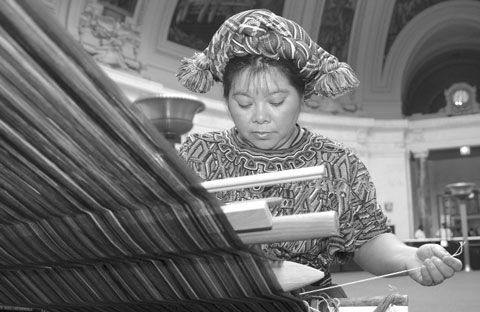By Kaitlen Jay Exum
At the foot of Bowling Green Park, The Smithsonian National Museum of the American Indian, is a gem for the whole family. The subject matter is interesting and the staff enthusiastic and helpful. Additionally, the museum boasts a variety of programs specifically designed for children and families.
Daily at 11 a.m. and noon, there are screenings of a collection of short films for children in the Video Viewing Room. The current program, (which runs until September 1), showcases a variety of Indian nations and includes the shorts: “We’re Still Dancing,” “Holy Dog,” “Lady Moon”, “Bear Dance,” and “The Buffalo Hunt.” The documentary-style “Bear Dance” and “We’re Still Dancing” are the best offerings of the collection, but, if the reactions of the children who were sitting behind me were any indication, kids should enjoy all of the videos.
Films for adults are shown daily at 1 p.m., and gallery discussion tours for both adults and children leave from the rotunda at 2 p.m. Each tour guide represents a different nation and explains exhibits from a unique cultural viewpoint. Angela was a wealth of information; engaging, knowledgeable, and earnest. She herself seemed captivated by the exhibit and gave a tour that was anything but standard.
Currently, only two exhibitions are open, as the third exhibit is in the process of being removed and will not be replaced until September. However, do not be fooled by the limited number of exhibits— the existing exhibitions are chock-full of art, artifacts, and information.
The larger of the two is “Legends of Our Times: Native Ranching and Rodeo Life on the Plains and the Plateau,” which boasts over 700 objects, dating from the 1800s on. This exhibit focuses on native peoples’ involvement in rodeos, ranching, and Wild West shows from the reservation period through the present. The items on display are predominantly on loan from an assortment of nations and range from clothing to saddlebags to veterinary supplies. Evidently, there are five sacred objects in the collection, so keep an eye out for them; they are all set on red cloth. The displays themselves are well designed, colorful and eye-catching. Items are presented in multi-level cases, so even small children can get some great views, and the exhibit is peppered with video screens and numerous panels of information, written in both English and French (the language common to most tribes for trade purposes). “Legends of Our Times” runs through March 7, 2004.
The second exhibit, “Continuum: 12 Artists,” features, at the moment, the work of Kay Walkingstick and Joe Feddersen. The Fedderson pieces are a particularly unique combination that showcases the artist’s basket weaving background and modernist aesthetic; blown glass cylindrical vases bear decorative patterns that look strangely familiar. Little wonder—the designs are based upon patterns so ubiquitous they go virtually unnoticed, like tire tracks, parking lot grids, and brick walls. Adults will appreciate the elegant simplicity and tongue-in-cheek humor of the works, while kids will enjoy spotting the everyday patterns in the art. Continuum runs until October 26, 2003, although the featured artists change.
In addition to the galleries and film screenings, the museum contains a resource center stuffed with books, videos, and interactive virtual tours on its computers. The museum hosts special programs as well, such as storybook readings on the second Saturday of each month at 2 p.m.
Just as noteworthy as its contents is the museum itself. It is in the former New York Customs House, which was nearly torn down and replaced with a skyscraper. Fortunately, it was refurbished rather than demolished. The result of the restoration is gorgeous, full of polished marble, shipping-themed murals, and carved ceilings. The splendor of the building and perhaps a stroll in Battery Park and the Esplanade, offers the possibility of a very picturesque day. The museum provides learning experiences galore in a lovely setting—and for free. It should be a must on every parent’s—make that every New Yorker’s—list.



































